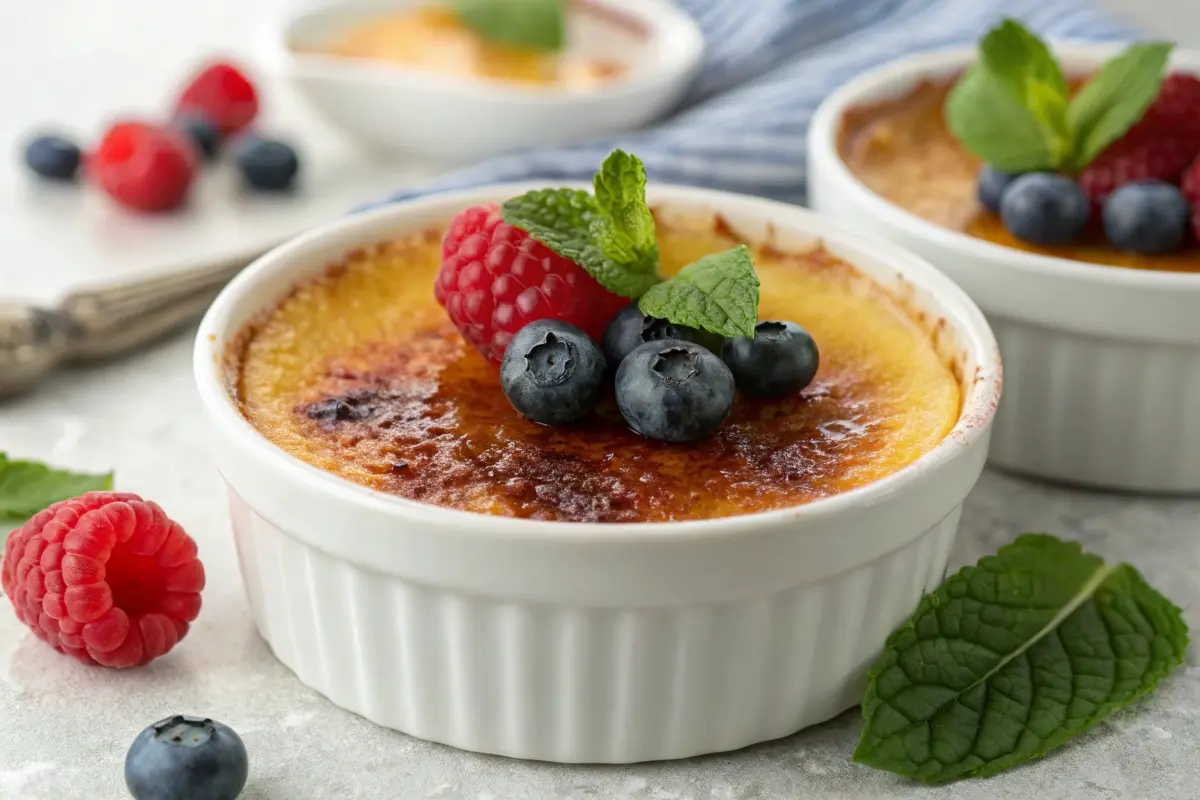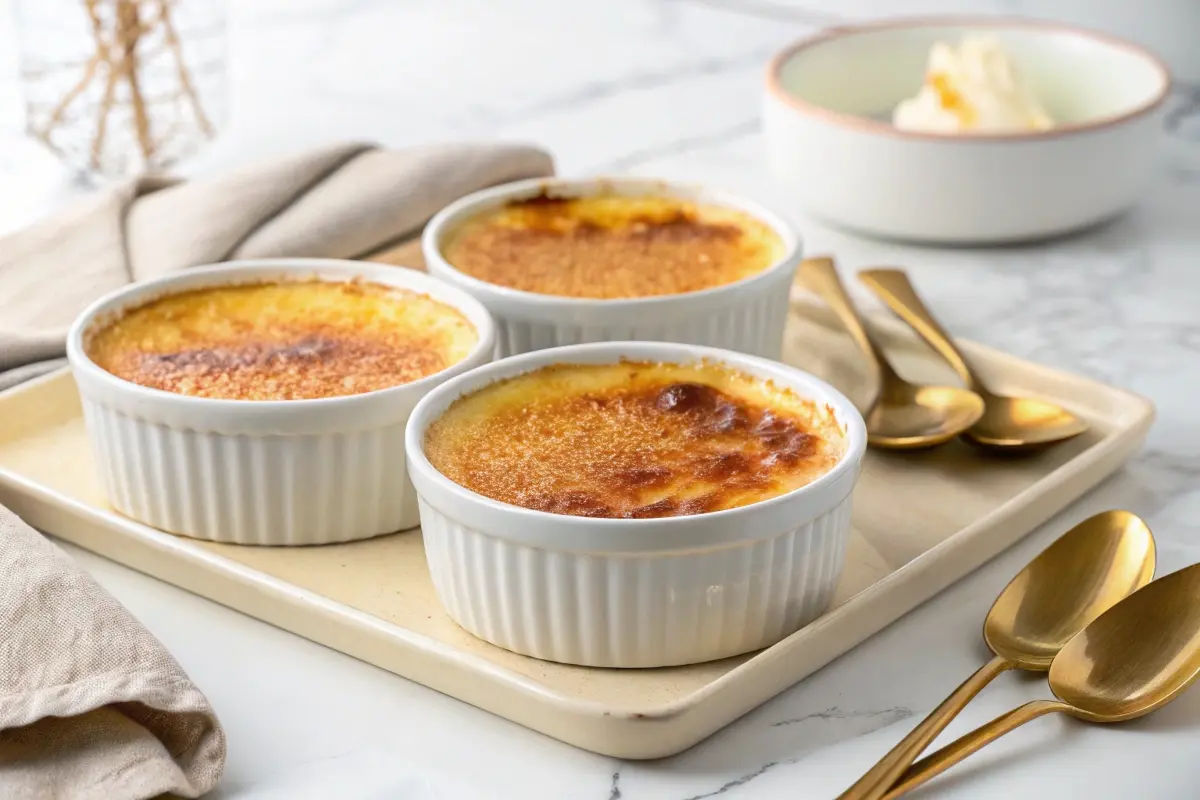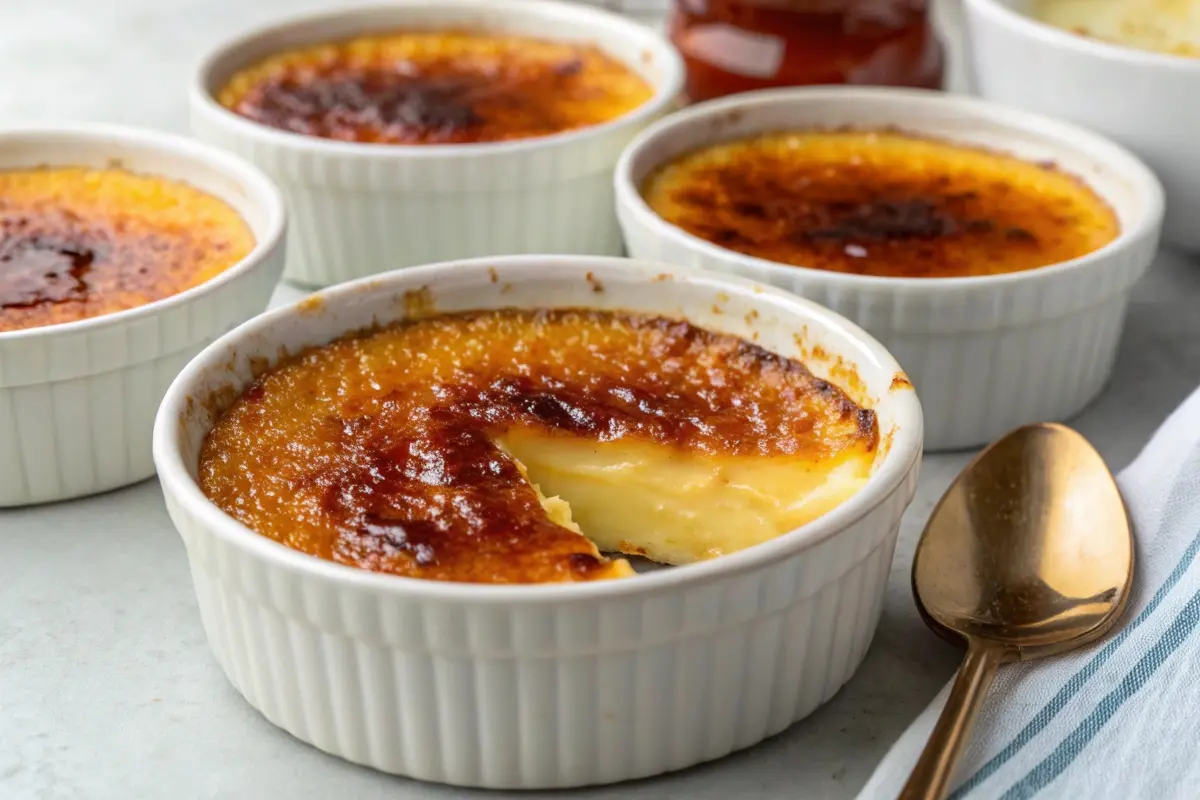Understanding Crème Brûlée and Its Ingredients
Crème brûlée, or “burnt cream,” is a classic French dessert that has captured the hearts of dessert lovers around the world. But why does it taste so good? It’s all about the simple yet magical combination of ingredients:
- Heavy cream for richness.
- Egg yolks for that custardy texture.
- Sugar for sweetness and the iconic caramelized crust.
- Vanilla for an irresistible aroma.
The silky custard paired with the crunch of caramelized sugar creates a delightful contrast. But here’s the thing—heavy cream plays a starring role. Its fat content gives the dessert its signature creamy texture. So, can milk step up to the plate?

The Role of Heavy Cream in Traditional Crème Brûlée
Heavy cream isn’t just there for show; it’s the backbone of the dessert. Its high-fat content (around 36-40%) creates a luscious mouthfeel and adds richness that makes every bite feel indulgent. Think of it like the heart of the recipe—it pumps life into the dish!
However, heavy cream can sometimes feel a bit too heavy for some. That’s why the idea of using milk might sound appealing. But before we swap, let’s weigh the pros and cons.
How Does Milk Compare to Heavy Cream in Texture and Flavor?
Milk and heavy cream are close cousins, but they’re definitely not identical twins. Here’s a quick comparison:
Fat Content
- Heavy cream: High fat, making it thick and rich.
- Milk: Low fat (2% or less), which means a thinner consistency.
Flavor Impact
When you use milk instead of heavy cream, the custard might lose some of its richness. The flavor will be lighter, but that’s not necessarily a bad thing if you prefer a more subtle sweetness.
Texture Changes
Milk won’t give you the same velvety texture. Think of it as swapping a luxury mattress for a standard one—it’s comfortable but not quite the same level of luxury.
Techniques for Using Milk Instead of Heavy Cream
Good news: You can use milk in crème brûlée! But, you’ll need to tweak a few things to make it work. Here are some tips to ensure your dessert turns out dreamy:
1. Adjust the Recipe
Since milk is thinner than cream, you might need to use less milk or add an extra egg yolk to maintain the custard’s structure.
2. Combine Milk with Other Ingredients
Want to mimic heavy cream’s creaminess? Try mixing milk with:
- Butter: Adds fat to match heavy cream’s richness.
- Cornstarch: Helps thicken the custard.
3. Mind the Baking Time
Milk-based custards might take a little longer to set. So, keep an eye on it and test for doneness with a gentle jiggle test.
Common Problems When Using Milk Instead of Heavy Cream
Swapping milk for heavy cream in crème brûlée may sound straightforward, but it can lead to a few hiccups. Let’s tackle the most common issues and their fixes!
Why Does the Custard Turn Out Watery?
A watery custard is a major disappointment, right? This happens because milk has a lower fat content, making it harder for the custard to set properly. To fix this:
- Increase the Egg Yolks: Adding one or two extra yolks can help bind the mixture.
- Use a Thickener: A teaspoon of cornstarch whisked into the milk can mimic heavy cream’s thickness.
- Cook Gently: Overheating can cause the custard to separate, so maintain a low and steady temperature.
How to Fix a Lack of Richness in Flavor
If your milk-based crème brûlée tastes too light, you’re not alone. Without the fat from heavy cream, the custard might feel less indulgent. Here’s how to elevate the flavor:
- Infuse the Milk: Simmer the milk with vanilla beans, citrus zest, or even cinnamon sticks for a more robust flavor.
- Add Butter: Stir in a tablespoon of melted butter to enrich the milk.
- Use Whole Milk: Skim or 2% milk won’t cut it here—always go for full-fat milk for the best results.
Expert Advice on Making Crème Brûlée with Milk
Even professional pastry chefs have tricks up their sleeves when it comes to using milk in crème brûlée. Let’s peek behind the curtain:
Temperature Control Is Key
Custard is delicate and doesn’t like surprises. Bake your crème brûlée in a water bath (a bain-marie) to maintain even heat. This ensures the custard sets smoothly without curdling.
“Consistency is everything in custards. Treat them gently, and they’ll reward you with perfect silkiness.” – Chef Elise Martin, Pastry Expert
Get Creative with Milk Mixtures
Why stop at plain milk? Try these combinations for a unique twist:
- Half Milk, Half Coconut Milk: Adds a tropical note to your dessert.
- Milk and Greek Yogurt: A tangy, creamy alternative.
- Milk and Condensed Milk: For added sweetness and density.

Alternative Substitutes for Heavy Cream in Crème Brûlée
If milk isn’t quite cutting it, don’t worry. There are other options to explore, depending on your dietary needs or what’s in your fridge.
Half-and-Half or Evaporated Milk
Both are closer to heavy cream in terms of texture and fat content. They’re excellent substitutes for those who want to stay closer to the original recipe.
Plant-Based Milk Options
For a dairy-free version, plant-based milks can be a game-changer:
- Coconut Milk: Rich and creamy, it works beautifully in custards.
- Cashew Milk: Offers a subtle nuttiness while keeping the texture smooth.
- Oat Milk: Great for a neutral flavor and silky consistency.
Nutrition Facts: Milk-Based Crème Brûlée
Here’s how a milk-based version compares to the traditional heavy cream recipe.
| Nutrient | Heavy Cream Version | Milk Version |
|---|---|---|
| Calories | ~300 per serving | ~180 per serving |
| Total Fat | ~25g | ~8g |
| Saturated Fat | ~15g | ~5g |
| Protein | ~5g | ~7g |
| Sugar | ~18g | ~20g |
While the milk version is lighter, you might notice a trade-off in creaminess. But for those looking to cut calories, it’s a win!
Balancing Health and Taste in Crème Brûlée
Can you really have it all—decadence and health? Surprisingly, yes! Using milk instead of heavy cream can strike a balance:
- Lower Calories: Perfect for those watching their intake.
- Easier Digestion: Milk is lighter and less taxing on the stomach.
- Same Indulgence: With the right tweaks, you can maintain that creamy, luxurious texture.
Enhancing Crème Brûlée with Unique Flavors and Milk Substitutions
Experimenting with milk-based crème brûlée opens the door to creative flavor infusions. While the classic vanilla custard is timeless, adding a twist can elevate your dessert to a whole new level. Here are some exciting ideas to try:
1. Vanilla Bean and Lavender Milk Crème Brûlée
Infuse the milk with fresh lavender flowers and a split vanilla bean. The floral notes from the lavender add an aromatic layer that complements the creamy custard. Strain the milk before mixing it into the custard to keep the texture smooth.
2. Citrus Zest for a Zippy Kick
Adding lemon, orange, or lime zest to your milk can create a bright, tangy profile. This works particularly well in a milk-based crème brûlée, as the lighter base allows the citrus flavors to shine.
3. Chocolate Milk Crème Brûlée
Yes, you read that right—chocolate milk! Using chocolate milk as a substitute adds a rich cocoa flavor to the custard. For a decadent dessert, top it with shaved dark chocolate after caramelizing the sugar.
4. Spiced Milk Variations
Infuse the milk with spices like cinnamon, cardamom, or nutmeg for a warm, cozy dessert perfect for the holiday season. You could even experiment with chai spices for a bold, tea-inspired custard.
Pro Tips for Flavor Infusions
- Heat the milk with your chosen ingredients, but don’t let it boil. A gentle simmer ensures the flavors meld beautifully.
- Let the infused milk cool slightly before adding it to the eggs to avoid curdling.
- Strain out any solids (zest, spices, flowers) for a silky-smooth custard.
These creative variations not only diversify your repertoire but also make milk-based crème brûlée a versatile and crowd-pleasing dessert. Whether you’re entertaining guests or treating yourself, these flavor experiments will keep the dessert exciting.

Reader FAQs on Crème Brûlée with Milk
Crème brûlée enthusiasts often have questions when experimenting with milk as a substitute for heavy cream. Here are some common concerns and clear, concise answers to help you succeed.
Can You Use Skim Milk for Crème Brûlée?
While it’s technically possible to use skim milk, it’s not ideal. The low fat content in skim milk results in a thinner, less creamy custard. If skim milk is your only option, consider adding melted butter or a thickening agent like cornstarch to improve the texture.
What Are the Best Milk-to-Egg Ratios for Crème Brûlée?
The standard ratio when using heavy cream is 1 cup of cream to 4 egg yolks. For milk, you may need to adjust slightly to maintain the custard’s structure. A good starting point is:
- 1 cup of whole milk
- 5 egg yolks
The extra yolk compensates for the lower fat content in milk and ensures the custard sets properly.
Does Milk Affect the Caramelized Top Layer?
Not at all! The caramelized sugar layer depends more on the sugar itself and your torching technique than on the custard base. Whether you use milk or heavy cream, you’ll still get that satisfying crack when you tap your spoon on the golden crust.
How Do You Prevent Milk-Based Crème Brûlée from Curdling?
Curdling happens when the custard gets too hot. To avoid this:
- Bake at a low temperature (around 300°F or 150°C).
- Always use a water bath to ensure gentle, even cooking.
- Check the custard frequently and remove it from the oven as soon as it’s set but still slightly jiggly in the center.
Can You Make Dairy-Free Crème Brûlée with Milk Alternatives?
Absolutely! Coconut milk and cashew milk are excellent substitutes for dairy. They provide the creaminess needed for a perfect custard while catering to lactose-intolerant or vegan dessert lovers.
Does Milk Change the Overall Taste of Crème Brûlée?
Milk creates a lighter, less rich version of crème brûlée. Some people enjoy the subtlety, as it allows other flavors like vanilla or citrus to shine more prominently. If you’re craving that decadent richness, consider blending milk with a bit of cream or butter.
Why Does Crème Brûlée Taste So Good?
Crème brûlée tastes so amazing because of its perfect balance of textures and flavors. The smooth, creamy custard base melts in your mouth, while the caramelized sugar layer adds a satisfying crunch. The richness from the heavy cream (or milk alternative) pairs beautifully with the sweet, slightly bitter caramel topping. Plus, the subtle aroma of vanilla enhances its overall indulgence. It’s a harmony of simplicity and sophistication, which is why it’s a favorite among dessert lovers!
Conclusion: Is It Worth Using Milk in Crème Brûlée?
So, can you use milk instead of heavy cream in crème brûlée? The answer is a resounding yes, but with a few caveats. While milk won’t provide the same luxurious richness, it opens up opportunities to create a lighter, healthier version of this beloved dessert. By tweaking the recipe, infusing bold flavors, and paying close attention to technique, you can still achieve a custard that’s smooth, creamy, and utterly delicious.
“Cooking is all about experimentation and making recipes your own. Don’t be afraid to try milk in crème brûlée—you might just discover a new favorite twist on a classic dessert!”
So, grab your whisk, preheat the oven, and give this swap a try. Your taste buds will thank you! 🥄✨
